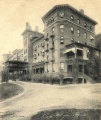Difference between revisions of "Jackson Sanitarium"
Trickrtreat (talk | contribs) (Created page with "{{infobox institution | name = Jackson Sanatorium | image = jackson1.jpg | image_size = 250px | alt = | caption = | established = | construction_began = 1854 | construction_end...") |
Trickrtreat (talk | contribs) |
||
| Line 12: | Line 12: | ||
| demolished = | | demolished = | ||
| current_status = [[Closed Institution|Closed]] | | current_status = [[Closed Institution|Closed]] | ||
| − | | building_style = [[ | + | | building_style = [[Single Building Institutions|Single Building]] |
| − | | architect(s) = | + | | architect(s) = Nathaniel Bingham |
| location = Dansville, NY | | location = Dansville, NY | ||
| architecture_style = | | architecture_style = | ||
| Line 27: | Line 27: | ||
==History== | ==History== | ||
| − | Construction of the Jackson Sanatorium began in 1854 by Nathaniel Bingham. | + | Construction of the Jackson Sanatorium began in 1854 by Nathaniel Bingham. When Bingham fell ill, Dr. James Caleb Jackson, a prominent doctor and survivor of childhood illness took over the project. Construction was completed later that year, and the facility opened as Jackson's "Home on the Hillside." The sanitarium served as a retreat and healing center, spreading Jackson's idea of health through hydrotherapy and a died with minimal meat consumption and heavy in fruits, vegetables, and grains. The doctor provided patients with an unprocessed grain source in the form of a bland, supplement made of bran and graham flour. The supplement, called granula by Jackson, was made chewable by soaking in water overnight and provided nutrition for patients of the resort. |
| − | <ref> Annetta Black, Martin, Rachel, Michelle Ferlito, Eric Grundhauser, Atlas Obscura. Jackson Sanatorium. 2014. Accessed Digitally March 12 2014. </ref> | + | In 1887, John Kellog, one of Jackson's colleagues, created a similar supplement, a biscuit made of whole grains like oats, wheat and corn meal. He called the product Biscuit Granula, and Jackson sought legal action against him for copyright infringement of the name. The case was settled, with Kellog adopting the name Granola. <ref> Annetta Black, Martin, Rachel, Michelle Ferlito, Eric Grundhauser, Atlas Obscura. Jackson Sanatorium. 2014. Accessed Digitally March 12 2014. </ref> |
| + | |||
| + | Jackson sanitarium featured other healing methods that were popular at that time, including maximum sunlight and fresh air. Each room had tall ceilings and windows placed to maximize air circulation. The roof of the building included rounded wood platforms enclosed in glass, allowing patients to be exposed to sunlight and fresh air. | ||
| + | |||
| + | After the Civil War, the facility served as a resort for wealthy people looking to be healed of physical and mental ailments. The doctor's ideas of natural healing were carried on at the facility. In the 1870's the aging Dr. Jackson handed over the care of the facility to his son and daughter in law, but in June of 1882, a fire broke out in the main building. The damage was repaired, and the building preserved by the family. By 1914 | ||
== Images of Jackson Sanitarium == | == Images of Jackson Sanitarium == | ||
| Line 49: | Line 53: | ||
[[Category:New York]] | [[Category:New York]] | ||
| − | [[Category: | + | [[Category:Single Building Institutions]] |
[[Category:Closed Institution]] | [[Category:Closed Institution]] | ||
Revision as of 07:36, 14 March 2014
| Jackson Sanatorium | |
|---|---|
 | |
| Construction Began | 1854 |
| Opened | 1854 |
| Closed | 1971 |
| Current Status | Closed |
| Building Style | Single Building |
| Architect(s) | Nathaniel Bingham |
| Location | Dansville, NY |
| Alternate Names |
|
History
Construction of the Jackson Sanatorium began in 1854 by Nathaniel Bingham. When Bingham fell ill, Dr. James Caleb Jackson, a prominent doctor and survivor of childhood illness took over the project. Construction was completed later that year, and the facility opened as Jackson's "Home on the Hillside." The sanitarium served as a retreat and healing center, spreading Jackson's idea of health through hydrotherapy and a died with minimal meat consumption and heavy in fruits, vegetables, and grains. The doctor provided patients with an unprocessed grain source in the form of a bland, supplement made of bran and graham flour. The supplement, called granula by Jackson, was made chewable by soaking in water overnight and provided nutrition for patients of the resort.
In 1887, John Kellog, one of Jackson's colleagues, created a similar supplement, a biscuit made of whole grains like oats, wheat and corn meal. He called the product Biscuit Granula, and Jackson sought legal action against him for copyright infringement of the name. The case was settled, with Kellog adopting the name Granola. [1]
Jackson sanitarium featured other healing methods that were popular at that time, including maximum sunlight and fresh air. Each room had tall ceilings and windows placed to maximize air circulation. The roof of the building included rounded wood platforms enclosed in glass, allowing patients to be exposed to sunlight and fresh air.
After the Civil War, the facility served as a resort for wealthy people looking to be healed of physical and mental ailments. The doctor's ideas of natural healing were carried on at the facility. In the 1870's the aging Dr. Jackson handed over the care of the facility to his son and daughter in law, but in June of 1882, a fire broke out in the main building. The damage was repaired, and the building preserved by the family. By 1914
Images of Jackson Sanitarium
Main Image Gallery: Jackson Sanitarium
References
- ↑ Annetta Black, Martin, Rachel, Michelle Ferlito, Eric Grundhauser, Atlas Obscura. Jackson Sanatorium. 2014. Accessed Digitally March 12 2014.






